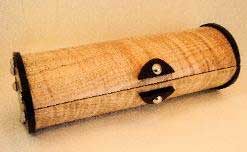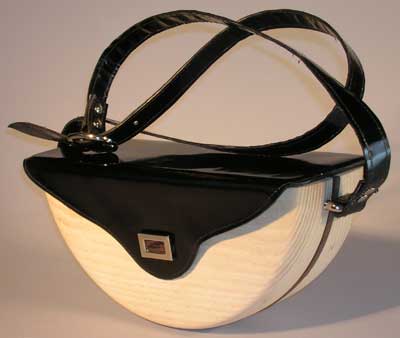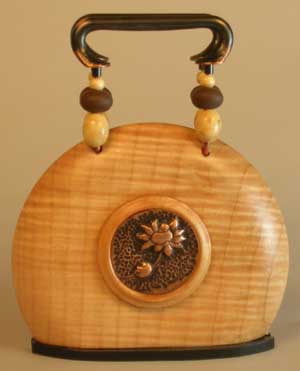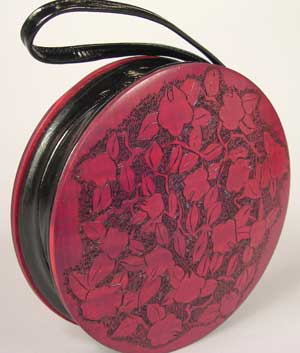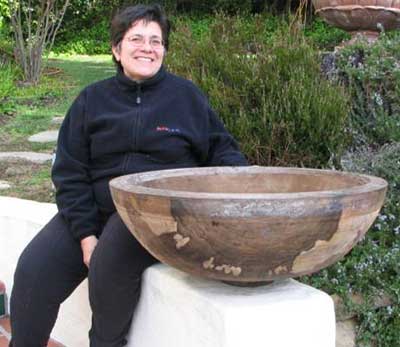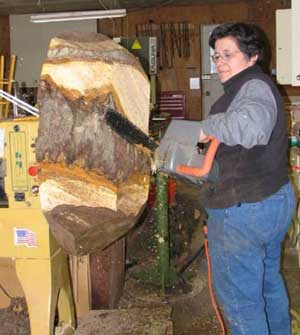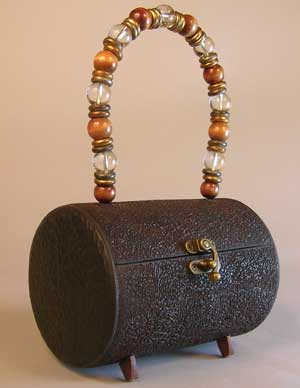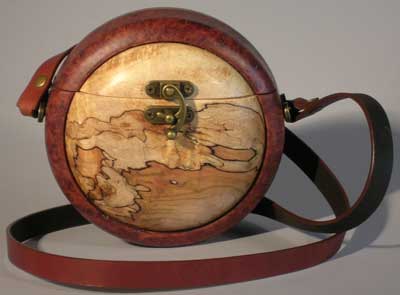
Denise DeRose has been a woodturner for a while — ever since she inherited her father’s shop, along with his love for wood – but she’s only been following her current focus in turning for about a year.
While working her booth at a craft show, she saw a woman carrying a small bandsawn box, about the size of a paperback book, as a handbag. “A light went off in my brain: why couldn’t it be a vessel? Woodturners make vessels. I started thinking about it, and I got consumed by it.”
Part of what interests her is the challenge of working out the design and functionality of turned purses: “How is it going to open? How is it going to close, and stay closed when you don’t want it open? Is it going to be carried in the hand, is it going to be carried over the shoulder, is it going to be carried under the arm? It’s something I would think about as I drove to my day job and then come home at night and sketch it.”
The first purses Denise made were canteen shaped, with a flat wood front and a channel for the strap inside the bag rather than outside. Lately, she’s started experimenting with therming, a traditional turning technique that’s been used for centuries to turn multiple objects mounted on a lathe, such as barrel staves: you end up with two sides, with a hollow form inside. She’s using the technique for clutch style handbags, and sometimes finishes off the other sides with the band saw.
She’s also working on figuring out a routing system on a track for use in constructing her handbags. “You’ve got to be able to rout a shape that’s roundish but not round and has nice, clean lines,” she said.
Denise herself is not a purse person. “I am the last kind of person you would think about when you think about handbags,” she said, with her focus being more on the functional than a fashion collection. As an art piece, though, “I think about handbags as a metaphor. What is it a woman brings with her? What is it she leaves behind? Few things are more connected to a woman than her handbag. What does a woman carry?”
At various points in her life, she has been a florist, a poet, a short story writer, a restorer of antique light fixtures – and a potter, and she says she thinks about teapots (her specialty as a potter) and handbags in much the same way: “A teapot can be very functional, something you use every day and can’t live without. It can also be something put on a shelf and treasured for beauty. Handbags cover a complete range, from absolutely functional to art.”
That intersection between functionality and art makes it somewhat difficult to find the right venue to sell her turned handbags, which are currently in a few boutiques, a couple art galleries, and some high-end craft shows. They’re most useful, she said, for a special occasion and evening bag, since, unlike large purses currently in style for everyday wear, none of hers exceeds 12 inches in diameter.
Her source for many of those 12” pieces of wood is cutoffs from instrument companies. Like the wood used in a violin or guitar, handbag wood needs to be stable, and companies who sell billets for construction of those instruments often have cutoffs she purchases. “I do a lot of glue-ups, or turn two discs and hollow and laminate them together,” she said.
One reason Denise likes the fiddleback maples she often gets from the instrument cutoffs is because of the way it takes a finish. “A handbag finish is crucial. It’s not something to just sit on a shelf; it’s in someone’s hands all the time.” She likes to use fabric dye, in a variety of colors, on the wood for her handbags, and fiddleback maple lends itself well to dying because of its chatoyance. Her Flower Drum Song bag, made from fiddleback maple dyed with red fabric dye with a lacquer finish, is one of her favorites: “It looks like wood and you can see that it’s wood, and it’s elegant and attractive.”
She also uses pyrography in completing the finished designs on her purses. “It’s a good way of definining areas, especially if you use dye or paint. It burns fibers of the wood and keeps the paint or dye from traveling, so it will stop where the burn lines are.”
Prior to her focus on handbags, Denise turned many salad bowls – including one, upon request, that was 30 inches in diameter, made from walnut. Getting that up on her lathe, Denise said, required “a jack and three teenage boys” – and is one reason she has rigged up a winch system from the I-beam of her garage shop to help in maneuvering large pieces of wood. Mostly, though, the challenges of salad bowls focused on design elements: “is it going to be deep, is it going to be shallow, is it going to have a big foot.”
These days, in addition to design, she has to turn some of her focus to hardware. Since she can’t find hinges for some of the shapes she makes – she needs them to open round, rather than flat – she’s been doing some metalsmithing to make her own, such as those for a Bentou Box purse.
She hasn’t counted all the purses she’s made so far, but says she has a long way to go. “I think creativity arises when you limit yourself. You don’t walk in the door of the shop and say, What am I going to make today?’ You know what you’re going to make, and you work within the parameters.”
For Denise, woodturning helps define those parameters. “Woodturning is my passion,” she said. “I’d much rather work with the lathe than with any other tool in the shop.”
